 Want to expand your ad reach on Facebook?
Want to expand your ad reach on Facebook?
Looking for new ways to target potential customers?
To explore creative ways to combine Facebook lookalike audiences with custom ad audiences, I interview Rick Mulready.
More About This Show
The Social Media Marketing podcast is an on-demand talk radio show from Social Media Examiner. It's designed to help busy marketers, business owners, and creators discover what works with social media marketing.
In this episode, I interview Rick Mulready. Rick is a Facebook ads expert and host of the podcast, The Art of Paid Traffic. He's also a regular speaker at Social Media Marketing World. His new membership site, The ROI Club, is focused on Facebook ads.
Rick explains custom and lookalike audience options that help you make the most of your customer list.
You'll also discover how to use website visitor data, engagements, and lead ads to find new potential customers.
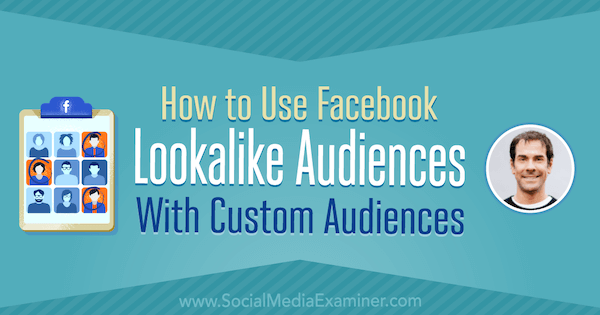
Share your feedback, read the show notes, and get the links mentioned in this episode below.
Listen Now
Where to subscribe: Apple Podcasts | Spotify | YouTube Music | YouTube | Amazon Music | RSS
Here are some of the things you'll discover in this show:
Facebook Lookalike Audiences
What Is a Facebook Lookalike Audience?
A lookalike audience is a targeting audience based on a custom audience. Examples of custom audiences include people on your email list, website visitors, and Facebook users who engage with your video or Facebook page. When you create a lookalike audience of a custom audience, Facebook finds users who have similar attributes to the people who are in that base custom audience.
For example, say you have an email list custom audience. To create that audience, you uploaded a list of 10,000 people and Facebook has matched those emails to 6,000 Facebook users. For a lookalike audience based on this custom audience, Facebook will look for Facebook users with similar attributes to those people on your email list.
Facebook knows a lot about its users. Although the data is anonymized, Facebook makes that data available to advertisers to help them reach their ideal target audience.
Get World-Class Marketing Training — All Year Long!
Are you facing doubt, uncertainty, or overwhelm? The Social Media Marketing Society can help.
Each month, you’ll receive training from trusted marketing experts, covering everything from AI to organic social marketing. When you join, you’ll also get immediate access to:
- A library of 100+ marketing trainings
- A community of like-minded marketers
- Monthly online community meetups
- Relevant news and trends updates
Listen to the show to hear Rick's and my thoughts about all of the things Facebook and Google know about users.
Why Use a Lookalike Audience?
Lookalike audiences give you a way to reach a cold audience beyond interest or behavior targeting. For example, say you're showing targeted ads to warm traffic, such as people on your email list, website visitors, or Facebook fans. Lookalike audiences give you a way to reach cold audiences that are like those warm audiences but much bigger.
Depending on how closely you want to match your base audience, you can set up a lookalike audience size that's anywhere from 1% to 10%, where the 1% includes only those people who most closely match your base audience. In the U.S., that 1% audience is about 2 million people. As you move toward 10%, the audience size increases but the matching becomes more generic.
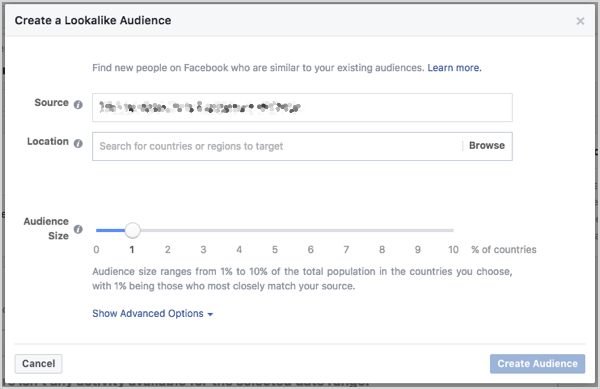
You can control the size with a slider that appears when you create the audience. In Facebook Ads Manager, open the Audiences tool and click the Create Audience button. Select the option to create a lookalike audience, and then a box pops up where you select a source, a location, and then the audience size.
The source is the custom audience on which you want to base the lookalike audience. The location is the country or regions on which you want to base the lookalike audience. The audience size has the slider that lets you choose 1%, 2%, 3%, and so on. You also see an advanced option to create multiple versions of that lookalike audience size.
Although a lookalike audience is a cold audience, it's not super-cold (compared to interest or behavior targeting) because Facebook is using the algorithm to match attributes from your warm audience to create this new lookalike audience. To reach new people who aren't already in your warm audiences on Facebook, you definitely want to use and test lookalike audiences.
Lookalike audiences are not only a great way to reach new people, but also tend to be less expensive than audiences based on interest or behavior targeting. However, to confirm that the cost for lookalikes will be lower for you, you have to test and compare the different audiences.
The most powerful reason to target a lookalike audience is to find people who are similar to your existing buyers. If you have a customer list, you can upload that list to Facebook and create a custom audience of your buyers. From there, you can create a lookalike audience based on your buyers, which targets people with similar attributes to those who made a purchase.
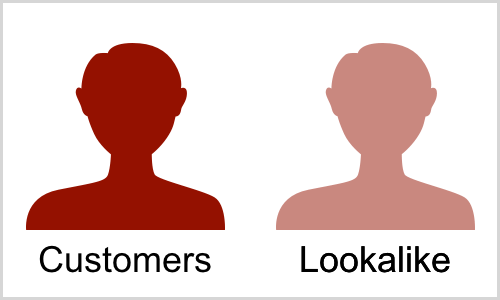
I ask if Rick recommends creating a bunch of different lookalike audiences. For example, if your email system does tagging, I wonder if you should create different lookalike audiences based on email subscribers who visit the website frequently versus those who don't.
Rick suggests that you do break out lookalike audiences in this way. Ideally, he adds, you want to think through your lookalike audiences strategically. However, if you're not sure what that strategy is yet, go ahead and create the audiences so that at least you have them. Later, when you understand your strategy a little better, you'll have the audiences so you can start using them to target your ads.
Listen to the show to hear how the audience percentage option is like a pyramid.
Location and Size Options for Lookalike Audiences
Rick and I then discuss how to select the location and size options for a lookalike audience. For location, Rick recommends selecting an option at the country level. Rick's recommendation for how to select the audience size percentage has changed over the past year.
Before, he would not go above 1% to keep the lookalike audience as specific as possible. Now, however, the algorithm seems to work better with larger audience sizes. The larger size gives the algorithm more data for finding people who are most likely to watch a video, convert, or otherwise opt in.
For that reason, Rick suggests testing those larger lookalike audience sizes of 2%, on up to maybe 5%. Depending on what type of business you have and who your customer is, you might test audience sizes with an even larger percentage. You can even split test a 1% versus a 5% audience.
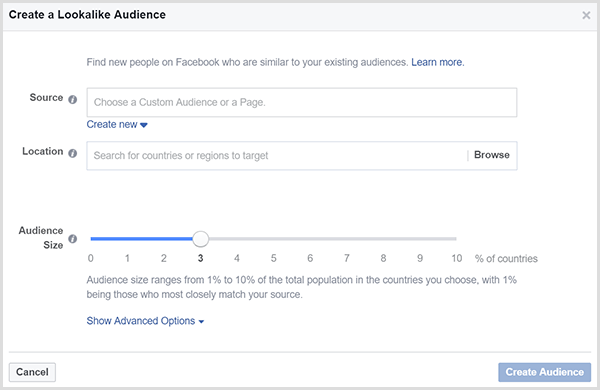
However, the results depend on your business. After you test a few different sizes, you may find that you get the best results with 1% audiences. Similarly, increasing the audience size to 4% or 5% might not make sense for a lot of businesses because their customers just aren't that broad in nature. The important thing is to test different sizes to figure out what works for you.
For some perspective, I ask Rick how big audiences with these different size options are. Rick says a 1% lookalike audience based on an email custom audience with 10,000 addresses is about 2 million people. As you go up a percent, the audience size roughly doubles to about 4 million.
Listen to the show to hear Rick's thoughts on targeting a smaller location like San Diego, California.
Creative Ideas for Lookalike Audience Sources
For your lookalike audience source, which is a custom audience, you can think creatively to reach different segments of your audience based on the actions they're taking in your business.
As mentioned earlier, you can segment your email list to target customers based on a specific product or service they've bought. If you host an event, think about how you can leverage that audience. You also have people who visited your website.
Customer List: For your customer list, although most people instruct Facebook to match users based on email address, you can enter 15 different matching points such as date of birth or phone number.
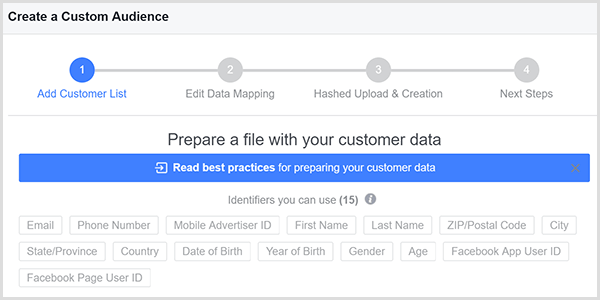
Also, if you happen to know your lifetime customer value, when you're uploading your list, you can include that number. Then Facebook lets you create a lookalike audience based on people who have high lifetime customer value. This option is powerful because you're asking Facebook to find people like customers who have an actual monetary value to your business.
With your customer list, the one thing you can't do is target people who have unsubscribed. The first time you create a custom audience, you have to agree to the terms and conditions. If someone opts out and says they don't wish to be contacted by you, you're supposed to remove them and not target them.
However, you might use a list of people who have unsubscribed to create a segment of people you want to exclude from your targeted ads. You can export that list from your CRM. By excluding these people, you can avoid negative feedback (although Facebook is doing away with ad feedback in favor of relevance score).
Website Visitors: For website visitors, the obvious idea is to create a custom audience of anybody who visited your website. You can limit that audience to people who visited between 1 and 180 days ago. The number of days you specify makes the audience ever-changing.
For example, if you create a 30-day audience, the audience updates constantly to target only people who visited the site in the previous 30 days. Even after you have this audience set up for a while, it updates every day so it only includes people from the past 30 days.
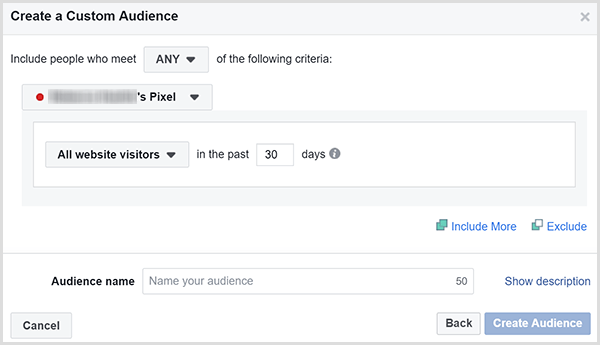
You can also create a custom audience of people who visit specific web pages. For example, you can set up an audience of people who visited the information page for your event. You can create another audience of people who visited the event page but didn't buy a ticket.
By creating the custom audience, you can build the audience of people visiting, and then the lookalike audience can find other people on Facebook who aren't part of your audience now but hopefully have the same interests as the people who are visiting your site.
Of course, you want your lookalike audience to be based on people who visit your website and take the desired action. For example, a custom audience of people who visited a sales page but didn't buy might be useful for other types of ads, but not ads targeted to a lookalike audience. The powerful lookalike audience is based on people who make a purchase or otherwise take action.
I ask if it's wise to combine email and website visitors into a super group of people who are both on an email list and visit the website. Rick likes this strategy but adds that it has pros and cons. One con is that this group will overlap somewhat. On the pro side, combining warm audiences increases your audience size, which provides the lookalike algorithm with more data for finding people.

Discover Proven Marketing Strategies and Tips
Want to go even deeper with your marketing? Check out the Social Media Marketing Podcast! Publishing weekly since 2012, the Social Media Marketing Podcast helps you navigate the constantly changing marketing jungle, with expert interviews from marketing pros.
But don’t let the name fool you. This show is about a lot more than just social media marketing. With over 600 episodes and millions of downloads each year, this show has been a trusted source for marketers for well over a decade.
Another option for website visitors is a custom audience of people based on how long they're spending on your website. This option is called Visitors by Time Spent. For the lookalike audience, you can choose the top 5%, top 10%, and top 25%, where the top 5% is the people who spend the most time on your site.
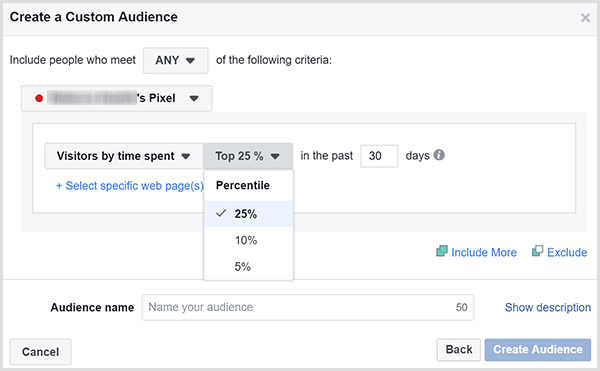
If you're using Facebook standard events so the Facebook pixel tracks events such as a registration or purchase, you can create a lookalike audience out of those actions as well.
Although email and website traffic are super-powerful, Facebook engagement audiences have been evolving recently and include some fun options.
Video Engagement: If you're sharing video on Facebook (whether it's uploading video or hosting Facebook Live videos), you can then create engagement audiences of people based on how long they watch your video.
For example, an audience of people who watched 75% of your video is a very powerful audience from which you can create a lookalike audience because you can assume that custom audience finds whatever you're talking about pretty engaging.
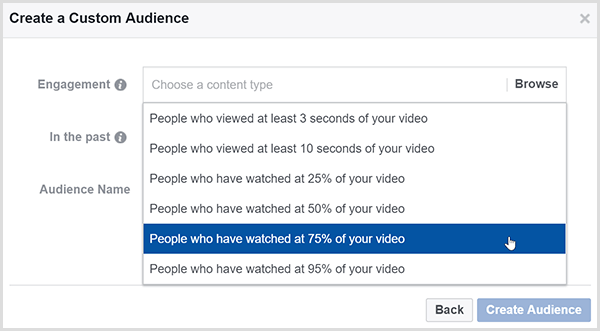
Depending on the size of your video audience, that custom audience can be a small group. Just know that you can create a lookalike audience of people based on how long people are watching your video. You could then target the lookalike audience based on a custom audience of video views with the video. In this way, you can try to get more video views.
Lead Ads: Lead ads allow users to populate a form with whatever information you've requested from their Facebook profiles. If you use lead ads, you can create a custom audience based on the action users take within the lead form, such as opening or submitting the form.
A custom audience based on lead ad actions is like creating an audience of people who have converted on your landing page. However, the form is on Facebook. From that custom audience, you can then create a lookalike audience.
Facebook Page Engagement: This option rolled out in 2017. You can create a custom audience based on people's engagement with your Facebook page. The option is called Everybody Who Engaged With Your Page, which includes people who have engaged with your posts or ads in the news feed, who have messaged you, or who have engaged in some other way.
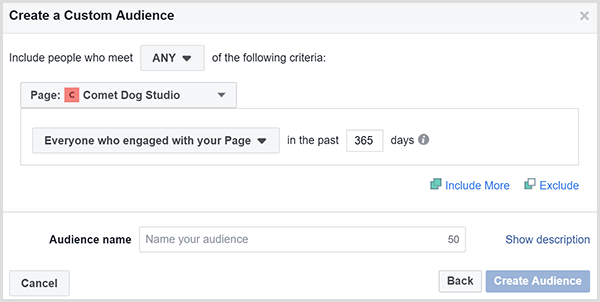
After you build a custom audience of those people, you can then create lookalike audiences based on that engaged audience. Although you don't currently have the option to narrow down the targeting to the way people engage (such as like versus love, comments, shares, etc.), Rick wouldn't be surprised if Facebook offers options like that in the future.
Instagram Engagement: If you have a business profile on Instagram, you can build a custom audience of people who are engaging with that profile and then also create a lookalike audience based on that custom audience as well. As with Facebook page engagement, you can specify the type of engagement, such as engaging with stories versus a post in the main Instagram feed or your profile.
Listen to the show to hear Rick and I discuss creating custom audiences of people who watch live video.
Examples
Rick uses these different custom and lookalike audiences in his business. The first example Rick shares focuses on starting to build relationships with cold audiences for his podcast. If he is getting a lot of traffic to the podcast pages on his website, he can use that traffic to create a custom audience of people who are interested in the podcast.
Then, to scale his campaign and reach new people, Rick could create a lookalike audience based on that custom audience. The ads he would show to the lookalike audience would feature the podcast so he can see who in the lookalike audience is interested in the podcast as well.
Because lookalike audiences are cold audiences who don't necessarily know who you are, your ads need to build trust and move people further down your sales funnel. You want people from this cold audience to become part of your warm audience. So in your ad content, you need to be careful not to overtly sell to your cold audiences.
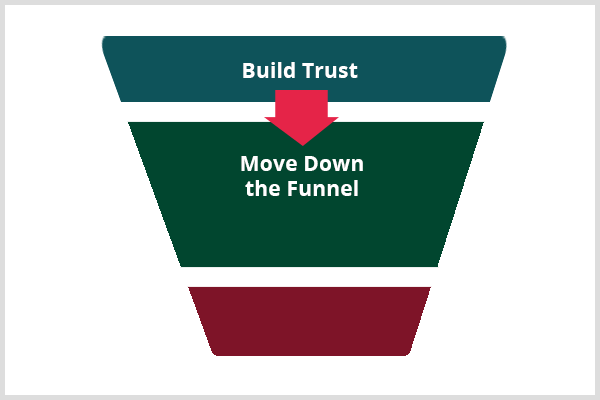
You want content that adds value or teaches your audience something. This content is what establishes trust, builds a relationship, and creates a perception in your audience's mind that you're a value provider. Those things allow your audience to buy from you down the road. In addition to content from a podcast, your ads might include a valuable link to an article or a video.
Rick and I then talk about adding interest targeting to a lookalike audience. For example, say you're targeting a 1% lookalike audience, and you add people who are interested in Social Media Examiner to the targeting. By further refining your lookalike audience, you're reaching a cold audience with attributes similar to your base audience, which adds an element of warmth to the audience.
Rick generally doesn't start by adding interest targeting to a lookalike. Instead, he tends to see how the lookalike audience does. If it's doing well, Rick leaves the lookalike audience as it is. If not, then he'll test adding interest targeting to the lookalike.
Rick also shares a strategy for combining lookalike audiences into one ad set. When he's testing different lookalikes, he might have a lookalike audience of his email list, a lookalike of people who are engaging with his Facebook page, and a lookalike of people who are visiting his website. If all of these lookalikes are performing pretty well, he combines them into one ad set.
By combining the lookalike audiences into one ad set, Rick is expanding the audience size so that Facebook's algorithm has more data to work with for scaling his ads. For example, if the lookalikes use the 1% option for size, combining them into one ad set increases the audience from 2 million people to about 6 million people.
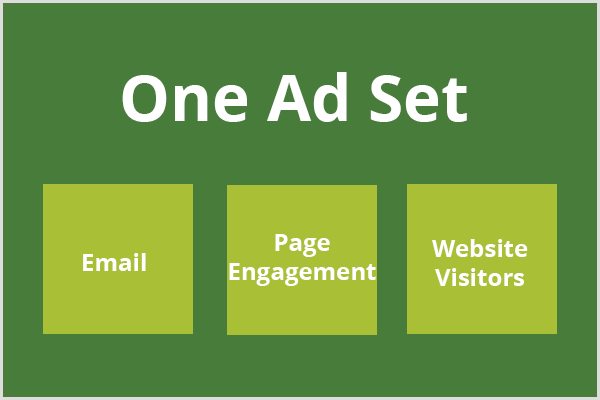
I ask if lookalike audiences are certain to be cold audiences or if you need to exclude fans and website visitors to reach true cold audiences. Rick says he uses exclusions to avoid overlap because he can make sure he's reaching new people while avoiding driving up prices.
Listen to the show to hear more of Rick's thoughts about whether lookalike audiences are true cold audiences.
Cost Management
To start testing custom audiences and lookalike audiences, your costs are generally low. Custom audiences of website visitors and your email list are much smaller than an interest-targeting audience. Lookalike audiences based on these custom audiences will be larger audiences but you can manage your costs by testing lookalikes with smaller budgets.
Testing also helps ensure your lookalikes are likely to be profitable before you spend lots of money on them. These audiences have been very successful for Rick overall, but not every audience is profitable. Testing with a smaller budget to see how your custom and lookalike audiences work helps you proceed with caution. Then, you can scale accordingly based on the results.
Listen to the show to hear Rick and I discuss what percentage of your ads budget is needed to start testing these audiences.
Discovery of the Week
Standuply is a Slack plugin that allows you to quickly and easily send video messages within Slack.
On Slack, people mostly use text, images, and GIFs. You can also do an audio call. Slack users with a paid plan can also make video calls, like a conference video call. With Standuply, you can add video to this mix because sometimes video conveys your message better than text.
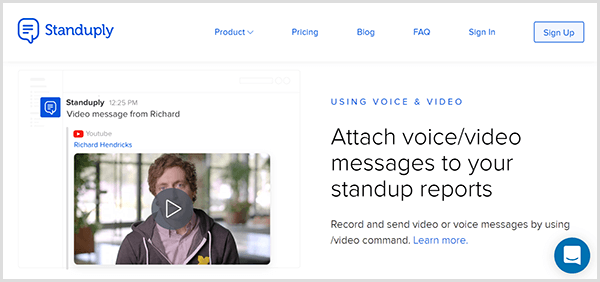
After you give the plugin access to your Slack channel or setup, you can just type “/video” and click the little button that appears, which opens your browser. Then you can stand in front of your webcam and add a video explanation or something similar.
Note that you can add only a limited number of extensions to your Slack install.
You can try Standuply for free and continue using the free version with up to three respondents. To share video messages with more respondents, you'll need to pay for the next tier of service, which is $5 per month.
Listen to the show and let us know how Standuply works for you.
Key takeaways mentioned in this episode:
- Visit Rick's website.
- Listen to Rick's podcast, The Art of Paid Traffic.
- Learn about The ROI Club, Rick's new membership site.
- Check out the different audience options in Facebook Ads Manager.
- Calculate lifetime customer value.
- Review the terms and conditions for Facebook custom audiences.
- Discover more about tracking website visitors with Facebook pixel and Facebook standard events.
- Get help setting your Facebook ads budget.
- Try the Standuply plugin for Slack.
- Watch our weekly Social Media Marketing Talk Show on Fridays at 10 AM Pacific on Crowdcast or tune in on Facebook Live.
- Download the 2017 Social Media Marketing Industry Report.
Help Us Spread the Word! Please let your Twitter followers know about this podcast. Simply click here now to post a tweet.
If you enjoyed this episode of the Social Media Marketing podcast, please head over to iTunes, leave a rating, write a review, and subscribe. And if you listen on Stitcher, please click here to rate and review this show.
What do you think? What are your thoughts on Facebook lookalike audiences? Please share your comments below.
Attention Agency Owners, Brand Marketers, and Consultants

Introducing the Marketing Agency Show–our newest podcast designed to explore the struggles of agency marketers.
Join show host and agency owner, Brooke Sellas, as she interviews agency marketers and digs deep into their biggest challenges. Explore topics like navigating rough economic times, leveraging AI, service diversification, client acquisition, and much more.
Just pull up your favorite podcast app, search for Marketing Agency Show and start listening. Or click the button below for more information.

